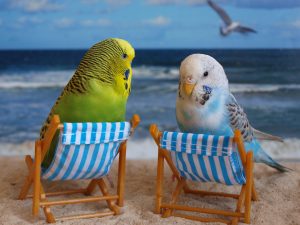
Humans aren’t the only species that require natural light to living a happy life. In fact, direct sunlight or full-spectrum bulb lighting is integral to the health and wellness of all pet birds.
On a day-to-day basis, light helps promote your bird’s natural circadian rhythms and can contribute to more restful sleep. In turn, better sleep can boost immune function, reduce exhaustion, and help keep anxiety or stress levels at bay. On a larger scale, seasonal light exposure can help promote various metabolic processes and trigger physical and behavioral changes associated with breeding, molting, and sleeping. Much like humans, lack of exposure to light can lead to Seasonal Affective Disorder (SADS), a condition similar to depression, when lacking in vitamin D3, which is derived from direct exposure to the sun.
What Kind Of Light
Exposure to natural and unfiltered sunlight is best which means taking your bird outside, however, since this is not always an option, the next best thing is a full-spectrum bulb that emits simulated natural sunlight including ultraviolet rays. It is important to note that simply sitting your bird in a window will not work since light filtered through glass or plastic loses the necessary wavelengths.
Vitamin D3 Deficiencies
If missing proper exposure, there are many common health problems associated with a vitamin D3 deficiencies in birds including:
- Breeding or reproduction issues such as soft shell eggs or egg binding problems. This is due to lack of calcium and the inability to produce the right elements for a strong egg.
- Physical abnormalities associated with vitamin D3 deficiencies like excessive feather plucking, overgrown beaks, splayed legs, and possible seizures.
- Cancer is also a result of lacking vitamin D since it helps reduce the growth of new blood vessels and can allow dormant tumors to turn cancerous. This self-destruction of mutated cells can be prevented with higher levels of vitamin D.
So How Much Light?
Although many breeds of birds have their own requirement when it comes to how much light is needed, a good rule of thumb is 12 hours of daylight contrasted with 12 hours of uninterrupted darkness. Talk to your bird’s veterinarian about your routine and what adjustments you should make throughout the course of a year to ensure your bird receives enough exposure to the sun.
**adapted from Wyld’s Kingdom and Pet MD**
2,100 total views, 11 views today
